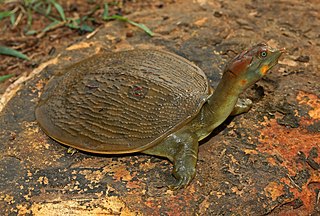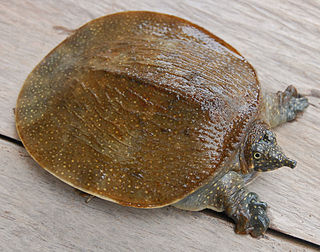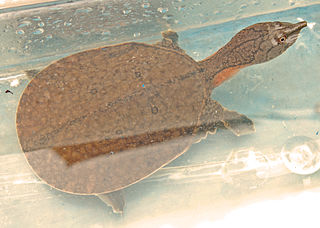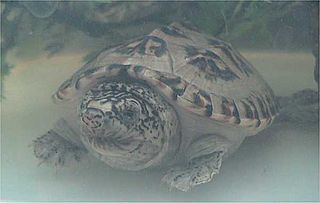
The Trionychidae are a taxonomic family of a number of turtle genera, commonly known as softshell turtles. The family was erected by Leopold Fitzinger in 1826. Softshells include some of the world's largest freshwater turtles, though many can adapt to living in highly brackish areas. Members of this family occur in Africa, Asia, and North America, with extinct species known from Australia. Most species have traditionally been included in the genus Trionyx, but the vast majority have since been moved to other genera. Among these are the North American Apalone softshells that were placed in Trionyx until 1987.

The pig-nosed turtle, also known as the pitted-shelled turtle or Fly River turtle, is a species of turtle native to northern Australia and southern New Guinea. It is the only living member of the family Carettochelyidae, which are related to softshell turtles.

The Indian narrow-headed softshell turtle, also known as the small-headed softshell turtle or the Indo-Gangetic softshell turtle, is an endangered species of softshell turtle native to waterways and rivers of the Indian subcontinent. It is very large, feeding on fish, frogs, worms, crustaceans and molluscs, and even the occasional swimming small rodent or other mammal. C. indica, like other softshell turtles, uses it flexible shell to dig itself deep into sandy lake and river bottoms; here, it patiently waits for potential prey to swim by. They will also ambush and chase their prey, depending on availability, the time of year, and size of the prey. In the past it was included as a subspecies of Chitra chitra, a species restricted to Southeast Asia using current taxonomy.

Leith's softshell turtle is a species of turtle in the family Trionychidae. The species is found in peninsular Indian rivers including the Thungabhadra, Ghataprabha, Bhavani, Godavari, Kaveri and Moyar Rivers. The type locality is Pune in India.

The Amboina box turtle or Southeast Asian box turtle is a species of Asian box turtle widely distributed across Southeast Asia. It is native to the Asian mainland from northeast India, through Bangladesh, Burma and Thailand, across Laos, Cambodia, Vietnam, and Malaysia. It is also found on the archipelagos of Indonesia and the Philippines.

The wattle-necked softshell turtle, also commonly known as Steindachner's soft-shelled turtle, is an endangered Asian species of softshell turtle in the family Trionychidae. The species is the only member of the genus Palea.

Pelochelys is a genus of very large softshell turtles in the family Trionychidae. They are found from peninsular India northeast to southern China, and south to Southeast Asia and New Guinea.

Apalone is a genus of turtles in the family Trionychidae. The three species of Apalone are native to freshwater habitats in North America; they are the only living softshell turtles from the Americas.

The Yangtze giant softshell turtle, also known commonly as the Red River giant softshell turtle, the Shanghai softshell turtle, the speckled softshell turtle, and Swinhoe's softshell turtle, is an extremely rare species of turtle in the family Trionychidae. It may be the largest living freshwater turtle in the world. The species is native to eastern and southern China and northern Vietnam. With a known population of only two or three individuals, and with the last known females dying out, this species is considered functionally extinct.

The Asiatic softshell turtle or black-rayed softshell turtle is a species of softshell turtle in the Trionychidae family. Despite its name, it is not the only softshell turtle in Asia.

The Malayan softshell turtle is a species of softshell turtle in the family Trionychidae. It is monotypic in its genus.

Nilssonia is a genus of softshell turtles from rivers, streams, ponds, and lakes in South Asia and Burma. In many treatments, it is monotypic, with the single species Burmese peacock softshell. However, the supposed other genus of peacock softshells, Aspideretes, is more closely related to N. formosa than had been believed. They differ only in the neural plates between the first pleural scale pair of the bony carapace, which are fused into one in N. formosa and unfused in the others.
The southern New Guinea giant softshell turtle is a species of softshell turtle in the family Trionychidae. The species is endemic to the lowlands of southern New Guinea with occasional vagrant individuals sighted off the coast of northern Australia. P. bibroni is referred to by the Suki people as kiya eise, a reference to its flexible shell. In the Arammba language, it is called sokrere, meaning "earthquake". It is sometimes hunted by local villages for its meat and/or eggs, leading to some cases of chelonitoxism.

The giant musk turtle, also known commonly as the Chiapas giant musk turtle or the Mexican giant musk turtle, is a species of turtle in the family Kinosternidae. The species is found in Central America.

The Mexican musk turtle, also known commonly as the giant musk turtle, is a species of turtle in the family Kinosternidae. The species occurs in Central America and Mexico.

The Euphrates softshell turtle, also known as the Mesopotamian softshell turtle, is a species of softshell turtle in the family Trionychidae. It is found throughout much of the Euphrates–Tigris river basin in Iraq, Syria, Turkey and Khūzestān Province of Iran. Historically it has also been reported from Israel, but this likely involves confusion with the very similar Trionyx triunguis.
The Burmese narrow-headed softshell turtle, also known commonly as the Myanmar narrow-headed softshell turtle and Van Dijk's chitra, is a species of turtle in the family Trionychidae. The species is endemic to Southeast Asia.
The northern New Guinea giant softshell turtle is a species of turtle found in the lowlands of northern New Guinea. South of the Central Range it is replaced by the closely related southern New Guinea giant softshell turtle. It is threatened by overhunting and harvesting of eggs as well as significant habitat loss of aquatic vegetation due to introduced fish species such as the red-bellied pacu.

Pelodiscus maackii, commonly known as the Amur softshell turtle or the northern Chinese softshell turtle, is a species of turtle in the family Trionychidae. The species is found in the Russian Far East, northeastern China, Korea, and Japan. It is possible that the Japanese populations are the result of ancient introductions by humans. This aquatic species may attain a straight carapace length of 32.5 cm (1.1 ft).
Giant softshell turtle may refer to the following:



















